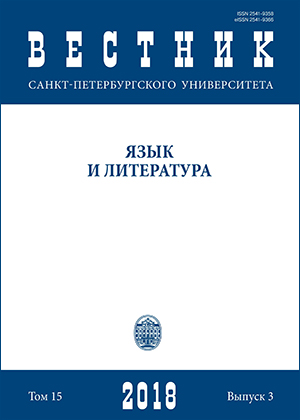Perceptual features of intervocalic consonant realizations used for -t-, -tt- (based on British news analytic discourse)
DOI:
https://doi.org/10.21638/spbu09.2018.308Abstract
During the last decade, two competing tendencies — globalization and national identity preservation — produced a considerable impact on the English-speaking World. One of the consequences of that process was a series of drastic changes that occurred in British English. It became the leader of instability and variability of pronunciation standard among the Englishes today. Various patterns of allophonic variation of intervocalic /t/ and its substitute with allophones of other phonemes such as tap / flap and sibilants can be named among those changes. The current perceptual study aimed at determining whether tapping / flapping and spirantization cases can lead to phonological changes and variability of the corresponding word phonemic pattern. 37 stimuli in VCV sequences that represented tapping acoustically similar to /d/, flapping similar to /r/ and /l/, sibilants similar to /ʃ/, /ʒ/, /s/, /z/ were segmented from the acoustic material. 8 realizations of the following phonemes /d/, /r/, /l/, /t/, /ʃ/, /ʒ/, /s/, /z/ were included into the experiment as a control group. Consequently, 45 stimuli were included into the perceptual study. A web-site was constructed to carry out the on-line perceptual experiment and collect and analyze the obtained data automatically. The randomized tokens for listening were uploaded and a questionnaire was published on the web-site. 16 native speakers took part in the experiment performing a discrimination task. 272 answers were received from the subjects to tap-and-flap-containing tokens. Among the responses, voiced consonant interpretations prevailed over voiceless ones (86 % vs 14 %). 63 % out of 86 % were /d/ responses and 13 % and 10 % were /r/ and /l/ responses correspondingly. 288 responses were obtained for 18 tokens that included sibilants. Among them, only 29 % on average accounted for plosives while 71 % accounted for fricative sibilants. Voiceless/voiced phonological feature and consonant loci feature taken separately were discriminated correctly for 72 % of the tokens.
Keywords:
perceptual cues, intervocalic word-medial and word-final position, news analytical discourse, tap / flap, spirantization, sibilants, phonological variance, English
Downloads
References
References
Downloads
Published
How to Cite
Issue
Section
License
Articles of "Vestnik of Saint Petersburg University. Language and Literature" are open access distributed under the terms of the License Agreement with Saint Petersburg State University, which permits to the authors unrestricted distribution and self-archiving free of charge.






